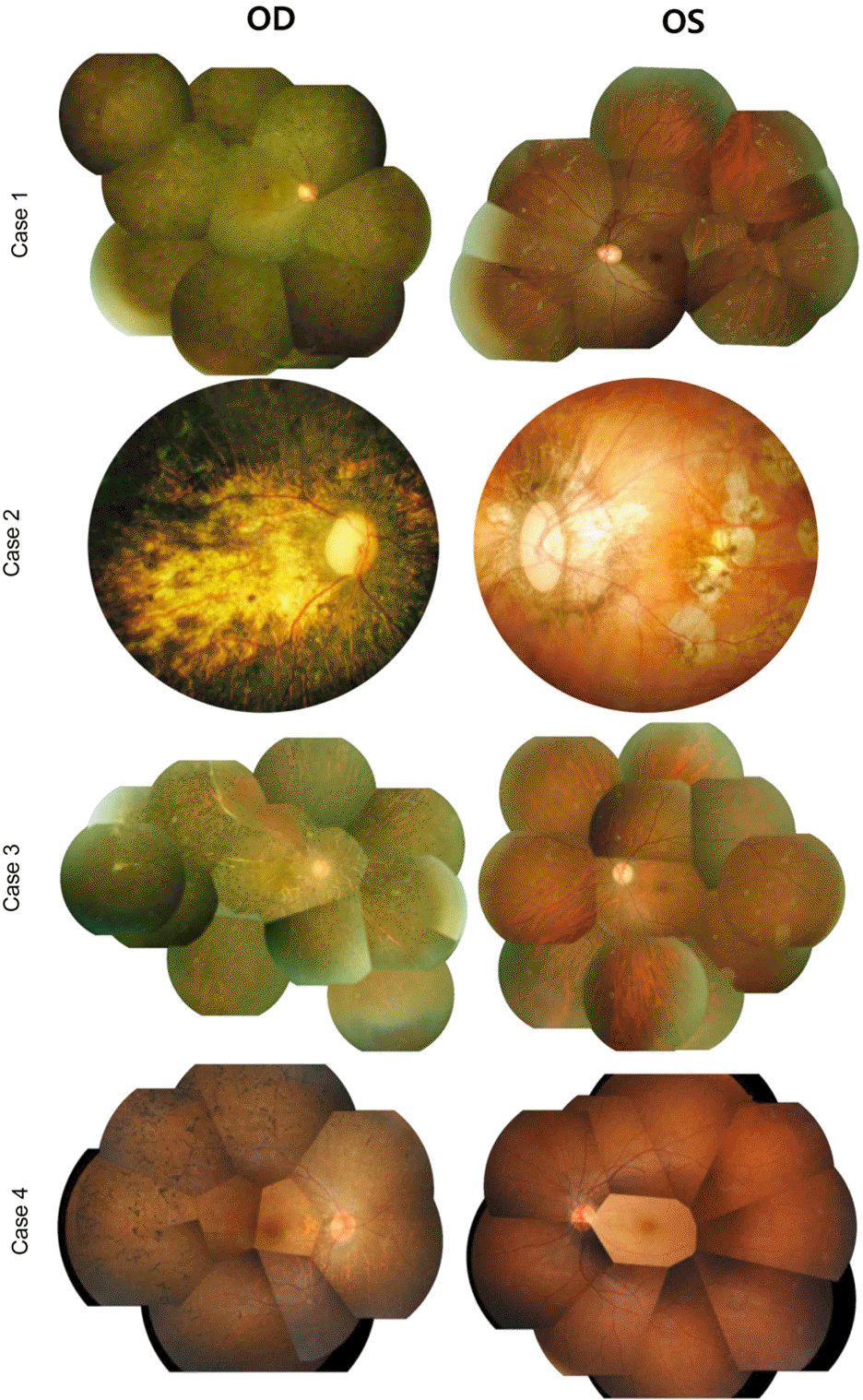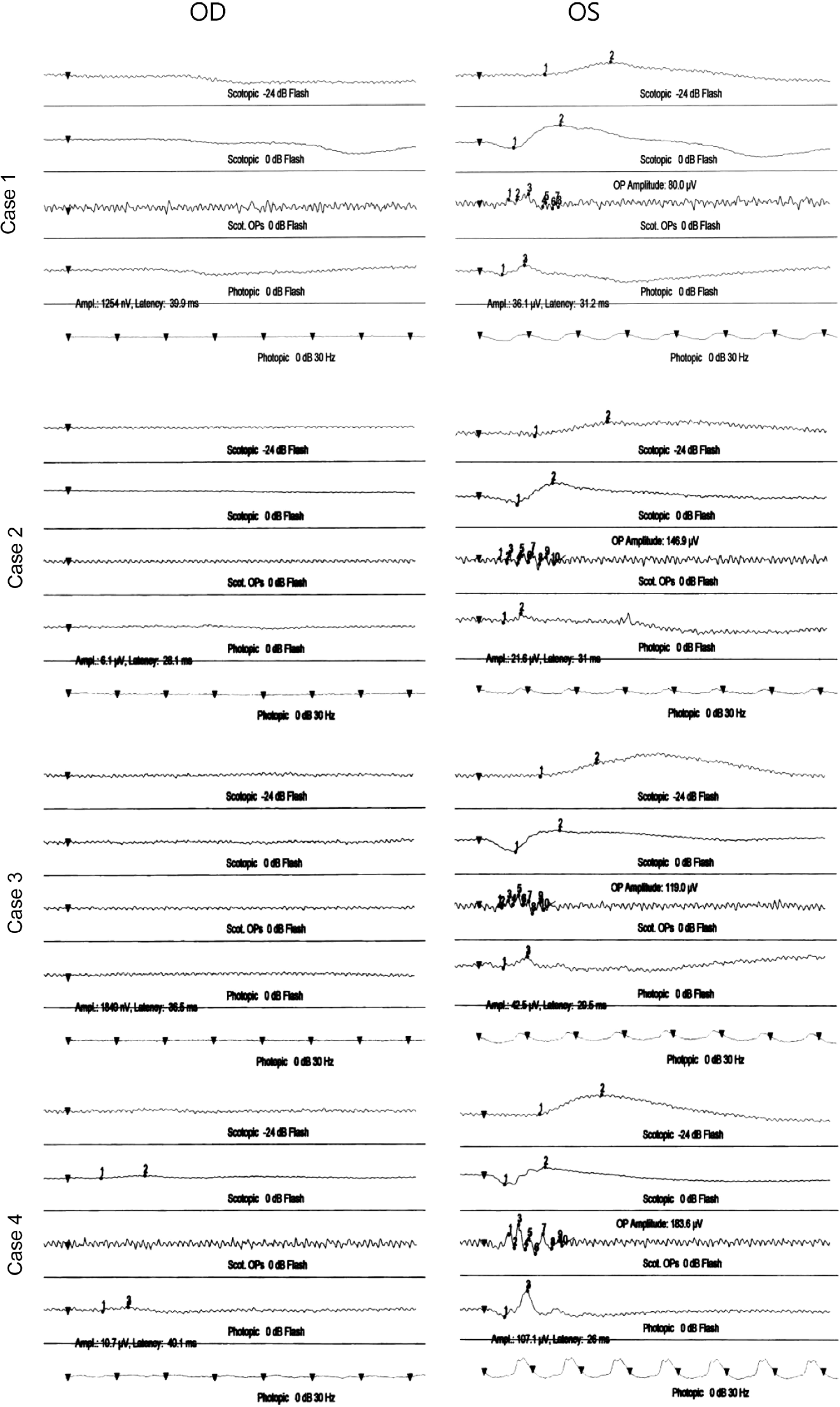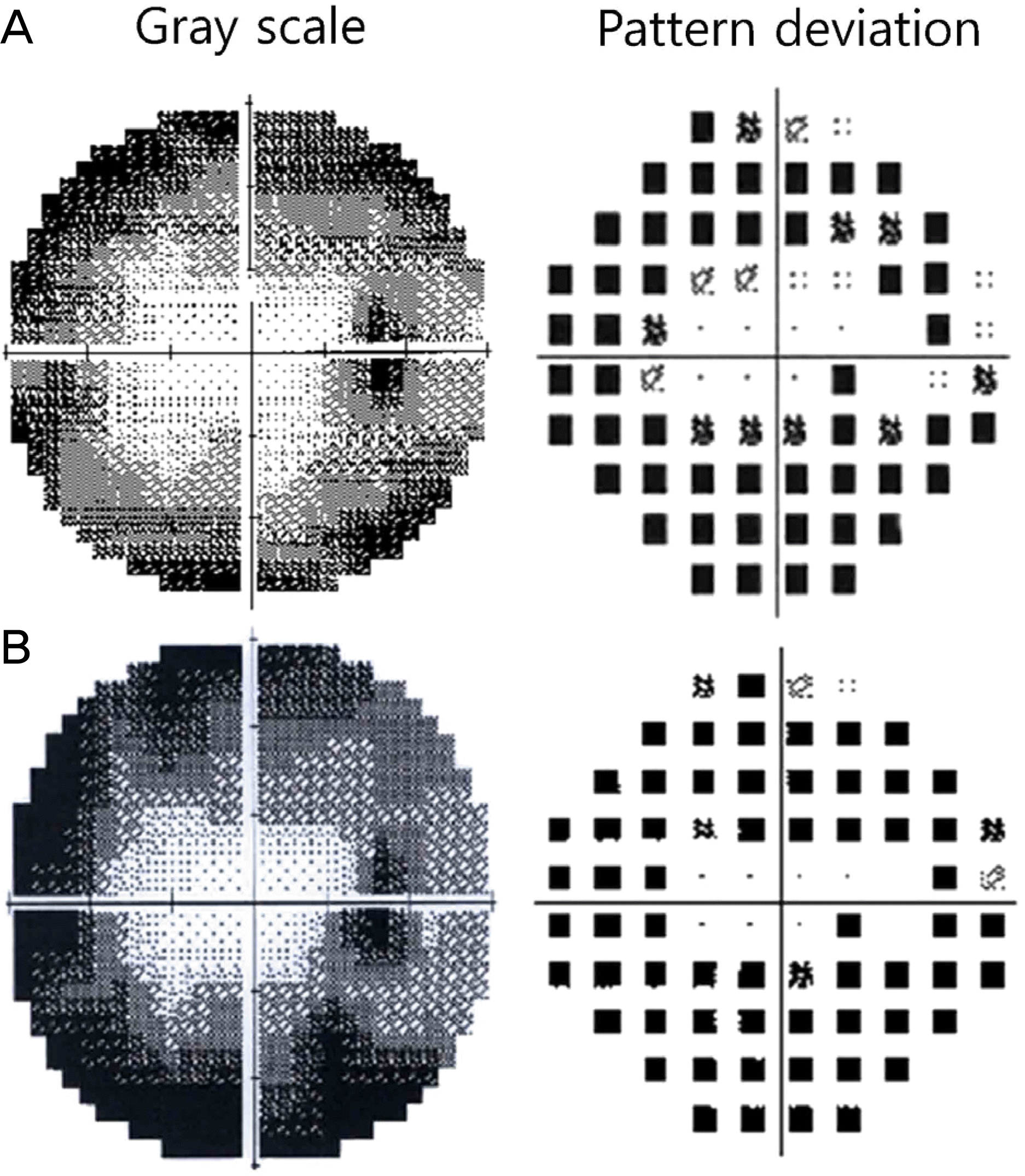초록
Methods:
A retrospective, observational case series of 4 URP patients with no signs of bilateral involvement during the follow-up period of up to 5 years.
Results:
The subjects were 4 female patients with an average age of 37 years. The mean follow-up period was 7 years. The subjects’ blood analysis excluded any infective diseases. History of trauma or any family history of ocular diseases including retinitis pigmentosa was absent. The full-field electroretinograms (ERGs) were normal in the unaffected eyes and the affected eyes showed markedly low or undetectable responses. Computerized visual field examinations were normal in the unaffected eyes, while 3 of the affected eyes had total visual field loss and 1 had concentric narrowing within 20 degrees.
Conclusions:
A long term follow-up of at least 5 years is required for diagnosis of URP to exclude a delayed onset in the unaffected eye. ERG is a reliable test to monitor the course of the disease and to confirm the diagnosis when uncertain. The etiology of URP is unknown although several studies regarding genetic causes that resulted in URP have been reported in recent years.
Go to : 
References
1. Carr RE, Noble KG. Retinitis pigmentosa. Ophthalmology. 1981; 88:169–72.
2. Grover S, Fishman GA, Anderson RJ, et al. Visual acuity impair-ment in patients with retinitis pigmentosa at age 45 years or older. Ophthalmology. 1999; 106:1780–5.

3. Bunker CH, Berson EL, Bromley WC, et al. Prevalence of retinitis pigmentosa in Maine. Am J Ophthalmol. 1984; 97:357–65.

4. Frank MH, Sayegh MH. Immunomodulatory functions of mesen-chymal stem cells. Lancet. 2004; 363:1411–2.

5. Noble KG, Carr RE. Peripapillary pigmentary retinal degeneration. Am J Ophthalmol. 1978; 86:65–75.

6. Francois J, Verriest G. Retinitis pigmentosa unilateral. Ophthalmologica. 1952; 124:65–88.
7. Pedraglia C. Retinitis pigmentosa. Klin Monbl Augenheilkd. 1865; 3:113–7.
8. Brill TF. Marcus Gunn pupil in a possible case of unilateral retinitis pigmentosa. Am J Optom Physiol Opt. 1979; 56:252–8.

9. Kim KH, Park YH, Hahn DK. A case of unilateral retinitis pigmentosa. J Korean Ophthalmol Soc. 1996; 37:1090–4.
10. Spadea L, Magni R, Rinaldi G, et al. Unilateral retinitis pigmentosa: clinical and electrophysiological report of four cases. Ophthalmologica. 1998; 212:350–4.

11. Chen H, Wu D, Huang S, Jiang F. Unilateral retinitis pigmentosa with amblyopia in the fellow eye. Graefes Arch Clin Exp Ophthalmol. 2006; 244:1701–4.

13. Potsidis E, Berson EL, Sandberg MA. Disease course of patients with unilateral pigmentary retinopathy. Invest Ophthalmol Vis Sci. 2011; 52:9244–9.

14. Dreisler KK. Unilateral retinitis pigmentosa; two cases. Acta Ophthalmol (Copenh). 1948; 26:385–93.
15. Kato K, Miyake Y, Matsubara H, Uji Y. Long-term follow-up of a case of unilateral retinitis pigmentosa. Nihon Ganka Gakkai Zasshi. 2012; 116:1086–93.
16. Marsiglia M, Duncker T, Peiretti E, et al. Unilateral retinitis pigmentosa: a proposal of genetic pathogenic mechanisms. Eur J Ophthalmol. 2012; 22:654–60.

17. Weller JM, Michelson G, Juenemann AG. Unilateral retinitis pigmentosa: 30 years follow-up. BMJ Case Rep. 2014; 2014.

18. Ryan SJ. Retina. 5th ed.Vol. 2. Philadelphia: Saunders;2013. p. 761–2.
19. Weiss JF, Nicholl RJ. Nonsyphilitic unilateral retinitis pigmentosa. Am J Ophthalmol. 1968; 65:573–4.

21. Svĕrák J, Peregrin J, Velický J. Unilateral pigmentary degeneration. A further case controlled by EOG and ERG. Acta Ophthalmol (Copenh). 1968; 46:1256–62.
22. Kandori F, Tamai A, Watanabe T, Kurimoto S. Unilateral pigmentary degeneration of the retina. Report of two cases. Am J Ophthalmol. 1968; 66:1091–101.
23. Farrell DF. Unilateral retinitis pigmentosa and cone-rod dystrophy. Clin Ophthalmol. 2009; 3:263–70.

24. Mukhopadhyay R, Holder GE, Moore AT, Webster AR. Unilateral retinitis pigmentosa occurring in an individual with a germline mu-tation in the RP1 gene. Arch Ophthalmol. 2011; 129:954–6.
Go to : 
 | Figure 1.Color fundus photographs of each patient showing typical retinitis pigmentosa abnormalities, including attenu-ated retinal arterioles, intraretinal clumps of black pigment, and loss of retinal pigment epithelium in the affected eye of each patient while the unaffected eyes are normal (the unaffected eye of patient 2 shows myopic fundus changes including localized chorioretinal atrophy and peripapillary atrophy). |
 | Figure 2.Full-field electroretinograms of each patient showing all 5 standard responses (rod response, maximal combined response, oscillatory potentials, cone response, 30-Hz flicker response). The responses are nearly non-recorded in the affected eyes while the unaffected eyes show nearly normal ERG responses. ERG = electroretinogram. |
 | Figure 3.Visual field change of affected eye in case 4. Concentric narrowing of visual field within 20 degrees was noticed at first visit (A). Six years later, the visual field was more narrowed about 5 degrees (B). Visual field using the Humphrey visual field analyzer (Carl-Zeiss Meditec, Dublin, CA, USA; C30-2 program). |
Table 1.
Demographic characteristics of the patients in unilateral RP
Table 2.
ERG values in unilateral RP at initial visit




 PDF
PDF ePub
ePub Citation
Citation Print
Print


 XML Download
XML Download